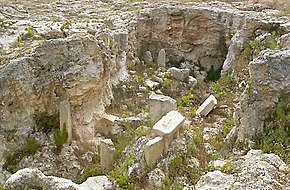Xagħra Stone Circle
| Iċ-Ċirku tax-Xagħra | |

Remains of the Xagħra Stone Circle
|
|
| Alternate name | Xagħra Hypogeum Brochtorff Circle |
|---|---|
| Location | Xagħra, Gozo, Malta |
| Coordinates | 36°2′47.2″N 14°15′53.9″E / 36.046444°N 14.264972°ECoordinates: 36°2′47.2″N 14°15′53.9″E / 36.046444°N 14.264972°E |
| Type | Hypogeum |
| History | |
| Material | Limestone |
| Founded |
c. 4100–3800 BC (earliest remains) c. 3000–2400 BC (main burial ground) |
| Abandoned | before 2000 BC |
| Periods |
Żebbuġ phase Tarxien phase Tarxien Cemetery phase Borġ in-Nadur phase |
| Site notes | |
| Excavation dates | 1826 and 1987–1994 |
| Condition | Ruins |
| Ownership | Government of Malta |
| Management | Heritage Malta |
| Public access | No |
The Xagħra Stone Circle (Maltese: Iċ-Ċirku tax-Xagħra), also known as the Xagħra Hypogeum or the Brochtorff Circle, is a prehistoric funerary complex located in Xagħra, Gozo, Malta. It consists of a series of underground caves which were used to bury the dead, and which were surrounded by a walled enclosure. It mainly dates back to around 3000 to 2400 BC, although the earliest tombs at the site date back to 4100 to 3800 BC. The caves collapsed sometime before 2000 BC, and the site was later used for domestic and agricultural purposes.
After being discovered in the late 18th century, the site was excavated in the 1820s before being reburied and forgotten. It was rediscovered in 1964, and major excavations took place between 1987 and 1994. It is the only prehistoric stone-enclosed hypogeum in Europe, and it is regarded as one of the most important archaeological sites in Malta along with the megalithic temples and the Hypogeum of Ħal-Saflieni.
When first discovered in 1788, the site was simply described as an "ancient structure" without a name. After it was depicted in paintings by Charles Brochtorff in the 1820s, the site was commonly referred to as the Brochtorff Circle, although it is not known who came up with this name.
The site eventually became known as the Xagħra Stone Circle or the Gozo Stone Circle. According to the archaeologist David Trump, these names are misnomers as there might be other stone circles in Xagħra or elsewhere in Gozo. In 2009, Trump coined the term Xagħra Hypogeum as the name best describing the site.
The Xagħra Stone Circle originally consisted of a walled enclosure surrounding underground caves which were used as a necropolis. It has some similarities to the Hypogeum of Ħal-Saflieni, a prehistoric funerary complex on the main island of Malta. However, Ħal-Saflieni is a man-made carved structure, while the Xagħra Stone Circle consists of natural caves which were adapted into a cemetery. Excavations at the site have shown that the bodies of the deceased were dismembered, and the different body parts were buried at separate places.
The site was the burial ground of the same community which built the nearby Ġgantija temple, which is now well-preserved. Several other temples might have stood in the vicinity, including at Santa Verna (where a few megaliths which are probably the remains of an important temple were found) and Ta' Ġesù.
...
Wikipedia

